
Scyliorhinidae is a family of sharks, one of a few families whose members share the common name catsharks, belonging to the order Carcharhiniformes, the ground sharks. Although they are generally known as catsharks, some species can also be called dogfish due to previous naming. However, a dogfish may generally be distinguished from a catshark as catsharks lay eggs while dogfish have live young. Like most bottom feeders, catsharks feed on benthic invertebrates and smaller fish. They are not harmful to humans. The family is paraphyletic, containing several distinct lineages that do not form a monophyletic group.

Apristurus is a genus of catsharks, the family Pentanchidae, the deepwater catsharks. The species in this genus are commonly known as the ghost or demon catsharks.

Galeus is a genus of deepwater catshark, belonging to the family Pentanchidae, commonly known as sawtail catsharks in reference to a distinctive saw-toothed crest of enlarged dermal denticles, found along the upper edges of their caudal fins. They are found in the Atlantic, the western and central Pacific, and the Gulf of California, inhabiting deep waters at or close to the sea floor. Members of this genus are rather small, slim sharks with firm bodies and thick, rough skin. Their heads are usually fairly long and pointed, and have large mouths with well-developed furrows at the corners. They have large pectoral and anal fins, and two similar dorsal fins placed well back. Many species are ornately patterned with dark saddles and/or blotches. Sawtail catsharks feed on various invertebrates and fishes, and may be either egg-laying or live-bearing. These harmless sharks are sometimes caught as bycatch but are of minimal commercial value.

The mouse catshark is a species of shark belonging to the family Pentanchidae, the deepwater catsharks. It is common in the northeastern Atlantic Ocean from Iceland to Western Sahara. There is much taxonomic confusion regarding this species in Icelandic waters, where it may be confounded with another species of Galeus or Apristurus. Probably not exceeding 49 cm (19 in) long, the mouse catshark has a uniformly brown body and is characterized by large, rounded pelvic fins and crests of enlarged dermal denticles along both the dorsal and ventral caudal fin margins. In addition, in adult males the inner margins of the pelvic fins are merged into an "apron".
The deepwater catshark is a species of shark belonging to the family Pentanchidae, the deepwater catsharks. This shark is found in the western Atlantic from Delaware Bay to Suriname, and in the eastern Atlantic from Morocco to northwest Africa. An important key factor to understanding these creatures is ageing, many deepwater Apristurus profundorum have poorly calcified vertebrae that lack visible growth bands, and most do not have dorsal fin spines that can be used for ageing. Other methods, such as captive growth and tag-recapture, are also limited in their suitability for deepwater chondrichthyans due to difficulties in the deep sea.

The white-bodied catshark is a catshark of the family Pentanchidae, the deepwater catsharks.
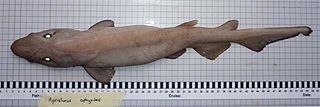
The white ghost catshark is a shark of the catshark family Pentanchidae, the deepwater catsharks. This shark is found in deep water in the northeast Atlantic between latitudes 57°N and 58°N. A deep-water catshark known from the eastern North Atlantic from depths of 1,014 to 1,800 m, it is known from only a limited number of specimens. It reaches a maximum of 54 cm or 1.7 ft total length which is a medium size for the Apristurus genus.

The shortnose demon catshark is a shark of the family Pentanchidae, the deepwater catsharks. This species is found only in deep water in the East China Sea. Its length is up to 40 cm. A. internatus is known only from the holotype and a paratype, both caught in the East China Sea, probably taken as bycatch in deepwater trawl fisheries. The reproduction of this catshark is oviparous.

The bulldog catshark is a species of shark belonging to the family Pentanchidae, the deepwater catsharks/ This shark is found in the deep waters of the East China Sea and in the Northwest Pacific. In New Zealand waters it is found at the Reinga Ridge, the West Norfolk Ridge, the Hikurangi Trough and the Chatham Rise as well as on the Campbell Plateau.

The Panama ghost catshark is a species of shark belonging to the family Pentanchidae, the deepwater catsharks. This little known catshark is only found off Panama, between 9°N and 2°N. The reproduction of the Panama ghost shark is oviparous.

The Saldanha catshark is a species of shark belonging to the family Pentanchidae, the deepwater catsharks. This catshark is found from Cape Columbine to south of False Bay in South Africa, between 31 and 40°S. Its length is up to 88 cm (35 in). It is a plain, dark grey-brown, stout catshark, with moderately large eyes, a broad snout, and large pectoral fins.

The largenose catshark is a species of shark belonging to the family Pentanchidae, the deepwater catsharks. The largenose catshark is found on the upper continental slopes in the eastern Pacific, from the Gulf of Panama to Ecuador and central Chile, between 9°N and 28°S. It can grow up to 70 cm. Its reproduction is oviparous. This nose shark is considered to be a harmless species. It is known to originate from the Gulf of Panama, Ecuador, and Central Chile.
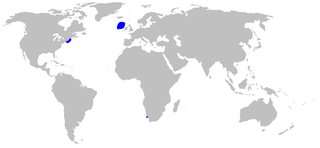
The ghost catshark is a species of shark belonging to the family Pentanchidae, the deepwater catsharks. This species is found on the continental slopes in the northwest Atlantic off Massachusetts, the northeast Atlantic from the Porcupine Bank west of Ireland and the southern Atlantic off Cape Town, at depths between 600 and 1,900 metres.
The black roughscale catshark is a species of shark belonging to the family Pentanchidae, the deepwater catsharks. It is recorded from the north Atlantic, eastern South Atlantic, in the Indian Ocean and around Australia and New Zealand. The species can be found on continental shelf at depths between 510 and 1,520 m. It can grow up to 90 cm (35 in).
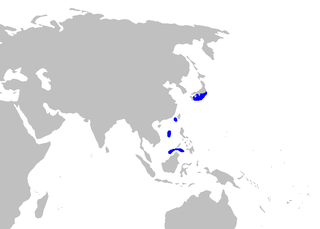
The spatulasnout catshark, also known as the Borneo catshark or flatnose catshark, is a species of shark belonging to the family Pentanchidae, the deepwater catshark. This shark is found in the western Pacific between 35°N and 1° N. Its length is up to 80 cm (31 in).

The longnose catshark is a species of shark belonging to the family Pentanchidae, the deepwater catsharks. This shark is found in the eastern central Pacific from central and southern California and the Gulf of California, between latitudes 38° N and 23° N, at depths down to 1,890. Its length is up to 58 cm.
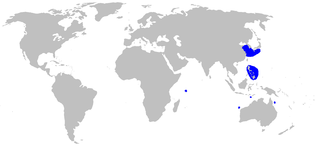
The longhead catshark or smoothbelly catshark is a species of shark, family Pentanchidae, the deepwater catsharks. This shark has a patchy distribution in the Indo-Pacific from Mozambique to southern Japan to northern Australia. It is found in water between 500 and 1,140 m deep. This species grows to 59 cm (23 in) long and is characterized by its extremely long and narrow snout, short abdomen, and long anal and caudal fins. In addition, a large area of the anterior ventral portion of its body lacks dermal denticles. The longhead catshark is oviparous and the only known cartilaginous fish that is normally hermaphroditic, with the majority of individuals having both the functional reproductive organs of one sex and the undeveloped reproductive organs of the opposite sex.
The roughskin catshark is a species of catshark in the family Pentanchidae, the deepwater catsharks. This species is found near Australia and New Zealand. Its natural habitat is the open seas. This species belongs to a genus of poorly known deep-water catsharks.
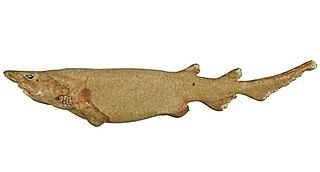
The bighead catshark is a species of fish in the family Pentanchidae, the deepwater catsharks. This species is endemic to Australia. Its natural habitat is the open seas. It belongs to a genus of poorly known deep-water catsharks, and is recorded from only three specimens taken off Perth, Western Australia. This species could be rare or uncommon, and the effects of fisheries are unknown, though if its biology is like other deep-water shark species, it may not be sufficiently fecund to withstand exploitation pressures.
The Pinocchio catshark is a species of catshark in the family Pentanchidae, the deepwater catsharks. This species is found in Australia and possibly New Zealand. Its natural habitat is the open seas. It belongs to a genus of poorly known deep-water sharks. Very little is known of its biology. Possibly a widely distributed deep-water catshark found along the Australian continental slope at depths of 590 to 1,000 m, it consists of several distinct populations which may be separate species. Although part of the distribution includes heavily fished areas, particularly off southeastern Australia, much of its range is in unfished areas. Given the taxonomic uncertainty of the separate populations, it is not possible to assess the conservation status of this species at this time. However, deep-water demersal trawl fisheries are expanding in the region, and the situation should be reassessed following taxonomic clarification.
















